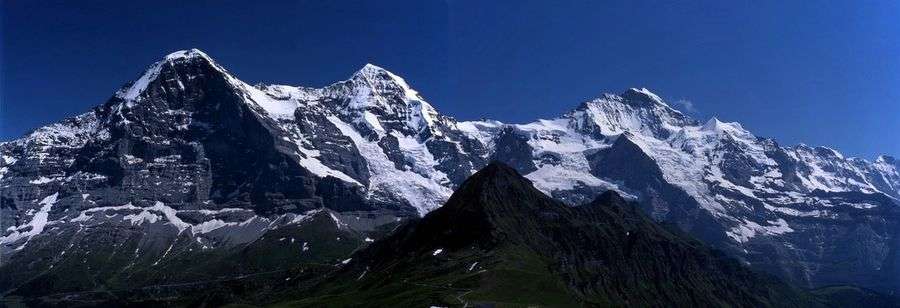Eiger
The Eiger is a 3,967-metre (13,015 ft) mountain of the Bernese Alps, overlooking Grindelwald and Lauterbrunnen in the Bernese Oberland of Switzerland, just north of the main watershed and border with Valais. It is the easternmost peak of a ridge crest that extends across the Mönch to the Jungfrau at 4,158 m (13,642 ft), constituting one of the most emblematic sights of the Swiss Alps. While the northern side of the mountain rises more than 3,000 m (10,000 ft) above the two valleys of Grindelwald and Lauterbrunnen, the southern side faces the large glaciers of the Jungfrau-Aletsch area, the most glaciated region in the Alps. The most notable feature of the Eiger is its 1,800-metre-high (5,900 ft) north face of rock and ice, named Eiger-Nordwand, Eigerwand or just Nordwand, which is the biggest north face in the Alps.[3] This huge face towers over the resort of Kleine Scheidegg at its base, on the homonymous pass connecting the two valleys.
| Eiger | |
|---|---|
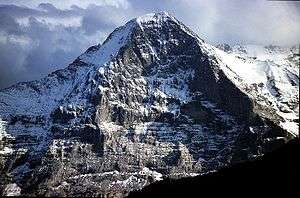 The north face of the Eiger | |
| Highest point | |
| Elevation | 3,967 m (13,015 ft) |
| Prominence | 362 m (1,188 ft) [1] |
| Parent peak | Mönch |
| Isolation | 2.0 km (1.2 mi) [2] |
| Listing | Great north faces of the Alps Alpine mountains above 3000 m |
| Coordinates | 46°34′39″N 8°0′19″E |
| Naming | |
| English translation | Ogre |
| Geography | |
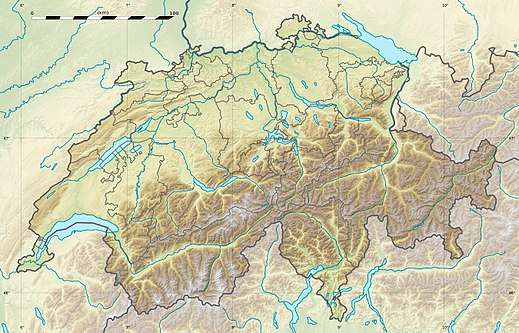 Eiger Location in Switzerland | |
| Location | Canton of Bern, Switzerland |
| Parent range | Bernese Alps |
| Topo map | Swisstopo 1229 Grindelwald |
| Geology | |
| Mountain type | Limestone |
| Climbing | |
| First ascent | 11 August 1858 |
| Easiest route | basic rock/snow/ice climb (AD) |
The first ascent of the Eiger was made by Swiss guides Christian Almer and Peter Bohren and Irishman Charles Barrington, who climbed the west flank on August 11, 1858. The north face, considered amongst the most challenging and dangerous ascents, was first climbed in 1938 by an Austrian-German expedition.[4] The Eiger has been highly publicized for the many tragedies involving climbing expeditions. Since 1935, at least sixty-four climbers have died attempting the north face, earning it the German nickname Mordwand, literally "murder(ous) wall"—a pun on its correct title of Nordwand (North Wall).[5]
Although the summit of the Eiger can be reached by experienced climbers only, a railway tunnel runs inside the mountain, and two internal stations provide easy access to viewing-windows carved into the rock face. They are both part of the Jungfrau Railway line, running from Kleine Scheidegg to the Jungfraujoch, between the Mönch and the Jungfrau, at the highest railway station in Europe. The two stations within the Eiger are Eigerwand (behind the north face) and Eismeer (behind the south face), at around 3,000 metres. Since 2016 the Eigerwand station is not regularly served any more.
Etymology
The first mention of Eiger, appearing as "mons Egere", was found in a property sale document of 1252, but there is no clear indication of how exactly the peak gained its name.[6] The three mountains of the ridge are commonly referred to as the Virgin (German: Jungfrau – translates to "virgin" or "maiden"), the Monk (Mönch), and the Ogre (Eiger; the standard German word for ogre is Oger). The name has been linked to the Latin term acer, meaning "sharp" or "pointed".
Geographic setting and description
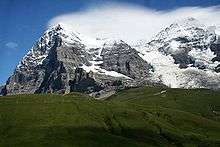
The Eiger is located above the Lauterbrunnen Valley to the west and Grindelwald to the north in the Bernese Highlands of the canton of Bern.[7] It forms a renowned mountain range of the Bernese Alps together with its two companions: the Jungfrau (4,158 m (13,642 ft)) about 5.6 kilometres (3.5 mi) southwest of it and the Mönch (4,107 m (13,474 ft)) about in the middle of them.[8] The nearest settlements are Grindelwald, Lauterbrunnen (795 m (2,608 ft)) and Wengen (1,274 m (4,180 ft)). The Eiger has three faces: north(west), (south)west, and east. The northeastern ridge from the summit to the Ostegg (lit.: eastern corner, 2,709 m (8,888 ft)), called Mittellegi, is the longest on the Eiger. The north face overlooks the gently raising Alpine meadow between Grindelwald (943 m (3,094 ft)) and Kleine Scheidegg (2,061 m (6,762 ft)), a mountain railways junction and a pass, which can be reached from both sides, Grindelwald and Lauterbrunnen/Wengen – by foot or train.[7]
Politically, the Eiger belongs to the municipality of Grindelwald. The Kleine Scheidegg (literally, the small parting corner) connects the Männlichen-Tschuggen range with the western ridge of the Eiger.[7] The Eiger does not properly form part of the main chain of the Bernese Alps, which borders the canton of Valais and forms the watershed between the Rhine and the Rhône, but constitutes a huge limestone buttress, projecting from the crystalline basement of the Mönch across the Eigerjoch. Consequently, all sides of the Eiger feed finally the same river, namely the Lütschine.[7]
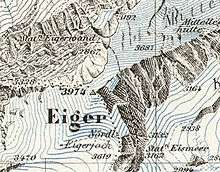
Eiger's water is connected through the Weisse Lütschine (the white one) in the Lauterbrunnen Valley on the west side (southwestern face of the Eiger), and through the Schwarze Lütschine (the black one) running through Grindelwald (northwestern face), which meet each other in Zweilütschinen (lit.: the two Lütschinen) where they form the proper Lütschine.[7] The east face is covered by the glacier called Ischmeer, (Bernese German for Ice Sea), which forms one upper part of the fast-retreating Lower Grindelwald Glacier. These glaciers' water forms a short creek, which is also confusingly called the Weisse Lütschine, but enters the black one already in Grindelwald together with the water from the Upper Grindelwald Glacier.[7] Therefore, all the water running down the Eiger converges at the northern foot of the Männlichen (2,342 m (7,684 ft)) in Zweilütschinen (654 m (2,146 ft)), about 10 kilometres (6.2 mi) northwest of the summit, where the Lütschine begins its northern course to Lake Brienz and the Aare (564 m (1,850 ft)).[7]
Although the north face of the Eiger is almost free of ice, significant glaciers lie at the other sides of the mountain. The Eiger Glacier flows on the southwestern side of the Eiger, from the crest connecting it to the Mönch down to 2,400 m (7,900 ft), south of Eigergletscher railway station, and feeds the Weisse Lütschine through the Trümmelbach. On the east side, the Ischmeer–well visible from the windows of Eismeer railway station–flows eastwards from the same crest then turns to the north below the impressive wide Fiescherwand, the north face of the Fiescherhörner triple summit (4,049 m (13,284 ft)) down to about 1,600 m (5,200 ft) of the Lower Grindelwald Glacier system.[7]
The massive composition of the Eiger, Mönch, and Jungfrau constitutes an emblematic sight of the Swiss Alps and is visible from many places on the Swiss Plateau and the Jura Mountains in the northwest. The higher Finsteraarhorn (4,270 m (14,010 ft)) and Aletschhorn (4,190 m (13,750 ft)), which are located about 10 kilometres (6.2 mi) to the south, are generally less visible and situated in the middle of glaciers in less accessible areas. As opposed to the north side, the south and east sides of the range consist of large valley glaciers extending for up to 22 kilometres (14 mi), the largest (beyond the Eiger drainage basin) being those of Grand Aletsch, Fiesch, and Aar Glaciers, and is thus uninhabited. The whole area, the Jungfrau-Aletsch protected area, comprising the highest summits and largest glaciers of the Bernese Alps, was inscribed as a UNESCO World Heritage Site in 2001.
In July 2006, a piece of the Eiger, amounting to approximately 700,000 cubic metres of rock, fell from the east face. As it had been noticeably cleaving for several weeks and fell into an uninhabited area, there were no injuries and no buildings were hit.[9]
North face

The Nordwand, German for "north wall" or "north face," is the north face of the Eiger (also known as the Eigernordwand: "Eiger north wall" or Eigerwand). It is one of the three great north faces of the Alps, along with the north faces of the Matterhorn and the Grandes Jorasses (known as 'the Trilogy'). It is about 1,800 m (5,900 ft) tall and overlooks Kleine Scheidegg and Grindelwald. At 2,866 metres inside the mountain lies the Eigerwand railway station. The station is connected to the north face by a tunnel opening at the face, which has sometimes been used to rescue climbers. The Eiger Trail, at the base of the north face, runs from Eigergletscher to Alpiglen railway stations.
It was first climbed on July 24, 1938 by Andreas Heckmair, Ludwig Vörg, Heinrich Harrer and Fritz Kasparek, a German–Austrian group. The group had originally consisted of two independent teams; Harrer and Kasparek were joined on the face by Heckmair and Vörg, who had started their ascent a day later and had been helped by the fixed rope that the lead group had left across the Hinterstoisser Traverse. The two groups, led by the experienced Heckmair, cooperated on the more difficult later pitches, and finished the climb roped together as a single group of four.
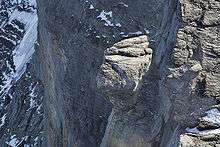
A portion of the upper face is called "The White Spider", as snow-filled cracks radiating from an ice-field resemble the legs of a spider. Harrer used this name for the title of his book about his successful climb, Die Weisse Spinne (translated into English as The White Spider: The Classic Account of the Ascent of the Eiger). During the first successful ascent, the four men were caught in an avalanche as they climbed the Spider, but all had enough strength to resist being swept off the face.
Since then, the north face has been climbed many times. Today it is regarded as a formidable challenge more because of the increased rockfall and diminishing ice-fields than because of its technical difficulties, which are exceeded by the 8,000 m peaks in the Himalaya and Karakoram. Climbers are increasingly electing to challenge the Eiger in winter, when the crumbling face is strengthened by ice.
Since 1935, at least sixty-four climbers have died attempting the north face, earning it the German nickname, Mordwand, or "murderous wall", a play on the face's German name Nordwand.[5]
Climbing history
While the summit was reached without much difficulty in 1858 by a complex route on the west flank, the battle to climb the north face has captivated the interest of climbers and non-climbers alike. Before it was successfully climbed, most of the attempts on the face ended tragically and the Bernese authorities even banned climbing it and threatened to fine any party that should attempt it again. But the enthusiasm which animated the young talented climbers from Austria and Germany finally vanquished its reputation of unclimbability when a party of four climbers successfully reached the summit in 1938 by what is known as the "1938" or "Heckmair" route.
The climbers that attempted the north face could be easily watched through the telescopes from the Kleine Scheidegg, a pass between Grindelwald and Lauterbrunnen, connected by rail. The contrast between the comfort and civilization of the railway station and the agonies of the young men slowly dying a short yet uncrossable distance away led to intensive coverage by the international media.
After World War II, the north face was climbed twice in 1947, first by a party of two French guides, Louis Lachenal and Lionel Terray, then by a Swiss party consisting of H. Germann, with Hans and Karl Schlunegger.[10]
First ascent
The first ascent was made by the western flank on August 11, 1858 by Charles Barrington with guides Christian Almer and Peter Bohren. They started at 3:00 a.m. from Wengen. Barrington describes the route much as it is followed today, staying close to the edge of the north face much of the way. They reached the summit at about noon, stayed for some 10 minutes and descended in about four hours. Barrington describes the reaching of the top, saying, "the two guides kindly gave me the place of first man up." Their ascent was confirmed by observation of a flag left on the summit. According to Harrer's The White Spider, Barrington was originally planning to make the first ascent of the Matterhorn, but his finances did not allow him to travel there as he was already staying in the Eiger region.[11]
Attempts on the north face
1935
In 1935 two young German climbers from Bavaria, Karl Mehringer and Max Sedlmeyer, arrived at Grindelwald to attempt to climb the face. They waited a long time for good weather and when the clouds finally cleared they started. The two climbers reached the height of the Eigerwand station and made their first bivouac. On the following day, because of the greater difficulties, they gained little height. On the third day they made hardly any vertical ground. That night a storm broke and the mountain was hidden in fog, and then it began to snow. Avalanches of snow began to sweep the face and the clouds closed over it. Two days later, there was a short moment when the clouds cleared and the mountain was visible for a while. The two men were glimpsed, now a little higher and about to bivouac for the fifth time. Then the fog came down again and hid the climbers. A few days later the weather finally cleared, revealing a completely white north face. The two climbers were found later frozen to death at 3,300 m, at a place now known as "Death Bivouac".[10][12]
1936
The next year ten young climbers from Austria and Germany came to Grindelwald and camped at the foot of the mountain. Before their attempts started one of them was killed during a training climb, and the weather was so bad during that summer that, after waiting for a change and seeing none on the way, several members of the party gave up. Of the four that remained, two were Bavarians, Andreas Hinterstoisser and Toni Kurz, and two were Austrians, Willy Angerer and Edi Rainer. When the weather improved they made a preliminary exploration of the lowest part of the face. Hinterstoisser fell 37 metres (121 ft) but was not injured. A few days later the four men finally began the ascent of the face. They climbed quickly, but on the next day, after their first bivouac, the weather changed; clouds came down and hid the group to the observers. They did not resume the climb until the following day, when, during a break, the party was seen descending, but the climbers could be seen only intermittently from the ground. The group had no choice but to retreat, since Angerer had suffered serious injuries from falling rock. The party became stuck on the face when they could not recross the difficult Hinterstoisser Traverse, from which they had taken the rope they had first used to climb it. The weather then deteriorated for two days. They were ultimately swept away by an avalanche, which only Kurz survived, hanging on a rope. Three guides started on an extremely perilous rescue attempt. They failed to reach him but came within shouting distance and learned what had happened. Kurz explained the fate of his companions: one had fallen down the face, another was frozen above him, and the third had fractured his skull in falling and was hanging dead on the rope.[10]
In the morning the three guides came back, traversing the face from a hole near the Eigerwand station and risking their lives under incessant avalanches. Toni Kurz was still alive but almost helpless, with one hand and one arm completely frozen. Kurz hauled himself off the cliff after cutting loose the rope that bound him to his dead teammate below and climbed back onto the face. The guides were not able to pass an unclimbable overhang that separated them from Kurz. They managed to give him a rope long enough to reach them by tying two ropes together. While descending, Kurz could not get the knot to pass through his carabiner. He tried for hours to reach his rescuers who were only a few metres below him. Then he began to lose consciousness. One of the guides, climbing on another's shoulders, was able to touch the tip of Kurz's crampons with his ice-axe but could not reach higher. Kurz was unable to descend further and, completely exhausted, died slowly.[10]
1937
An attempt was made in 1937 by Mathias Rebitsch and Ludwig Vörg. Although the attempt was unsuccessful, they were nonetheless the first climbers who returned alive from a serious attempt on the face. They started the climb on 11 August and reached a high point of a few rope lengths above Death Bivouac. A storm then broke and after three days on the wall they had to retreat. This was the first successful withdrawal from a significant height on the wall.[13]
First ascent of the north face
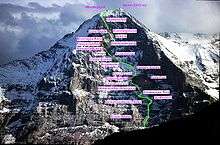
The north face was first climbed on July 24, 1938 by Anderl Heckmair, Ludwig Vörg, Heinrich Harrer and Fritz Kasparek in a German–Austrian party. The party had originally consisted of two independent teams: Harrer (who did not have a pair of crampons on the climb) and Kasparek were joined on the face by Heckmair and Vörg, who had started their ascent a day later and had been helped by the fixed rope that the lead team had left across the Hinterstoisser Traverse. The two groups, led by the experienced Heckmair, decided to join their forces and roped together as a single group of four. Heckmair later wrote: "We, the sons of the older Reich, united with our companions from the Eastern Border to march together to victory."[10]
The expedition was constantly threatened by snow avalanches and climbed as quickly as possible between the falls. On the third day a storm broke and the cold was intense. The four men were caught in an avalanche as they climbed "the Spider," the snow-filled cracks radiating from an ice-field on the upper face, but all possessed sufficient strength to resist being swept off the face. The members successfully reached the summit at four o'clock in the afternoon. They were so exhausted that they only just had the strength to descend by the normal route through a raging blizzard.[10]
Other routes
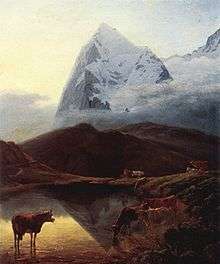
- 1857: First attempt by Christian Almer, Christian Kaufmann, Ulrich Kaufmann guiding the Viennese alpinist Sigismund Porges. They did manage the first ascent of neighboring Mönch, while Porges has the second ascend of the Eiger in July 1861 with the guides Christian Michel, Hans and Peter Baumann.[14]
- 1858: First ascent, by the west flank, 11 August (Christian Almer and Peter Bohren guiding Charles Barrington). According to Harrer's "The White Spider," Barrington would have attempted the first Matterhorn ascent instead, but his finances did not allow him to travel there as he was already staying in the Eiger region.
- 1864 (Jul 27): Fourth ascent, and first ascent by a woman, Lucy Walker, who was part of a group of six guides (including Christian Almer and Melchior Anderegg) and five clients, including her brother Horace Walker[14]
- 1871: First ascent by the southwest ridge, 14 July (Christian Almer, Christian Bohren, and Ulrich Almer guiding W. A. B. Coolidge and Meta Brevoort).
- 1890: First ascent in winter, Ulrich Kaufmann and Christian Jossi guiding C. W. Mead and G. F. Woodroffe.
- 1921 (10 September): First ascent via the Mittellegi ridge by Fritz Amatter, Samuel Brawand, Yuko Maki and Fritz Steuri.
- 1924: First ski ascent and descent via the Eiger glacier by Englishman Arnold Lunn and the Swiss Fritz Amacher, Walter Amstutz and Willy Richardet.
- 1932: First ascent of the northeast face ("Lauper route") by Hans Lauper, Alfred Zürcher, Alexander Graven and Josef Knubel[14]
- 1970: First ski descent over the west flank, by Sylvain Saudan.
- 1986: Welshman Eric Jones becomes the first person to BASE jump from the Eiger.
- 1988: Original Route (ED2), north face, Eiger (3970m), Alps, Switzerland, first American solo (nine and a half hours) by Mark Wilford.[15]
- 1991: First ascent, Metanoia Route, North Face, solo, winter, without bolts, Jeff Lowe.
- 1992 (18 July): Three BMG/UIAGM/IFMGA clients died in a fall down the West Flank: Willie Dunnachie; Douglas Gaines; and Phillip Davies. They had ascended the mountain via the Mittellegi Ridge.
- 2006 (14 June): François Bon and Antoine Montant make the first speedflying descent of the Eiger.[16][17]
- 2006 (15 July): Approximately 700,000 cubic metres (20 million cubic feet) of rock from the east side collapses. No injuries or damage were reported.[18]
- 2015 (23 July): A team of British Para-Climbers reached the summit via the West Flank Route. The team included John Churcher, the world's first blind climber to summit the Eiger, sight guided by the team leader Mark McGowan. Colin Gourlay enabled the ascent of other team members, including Al Taylor who has multiple sclerosis, and the young autistic climber Jamie Owen from North Wales. The ascent was filmed by the adventure filmmakers, Euan Ryan & Willis Morris of Finalcrux Films.
Climbs and attempts on the north face
1930s and 1940s
- 1934: First attempt on the face, by Willy Beck, Kurt Löwinger and Georg Löwinger, reaching 2,900 m.
- 1935: Attempt by the Germans Karl Mehringer and Max Sedlmeyer. They froze to death at 3,300 m, a place now known as "Death Bivouac."
- 1936: Four Austrian and German climbers, Andreas Hinterstoisser, Toni Kurz, Willy Angerer and Edi Rainer, died on the face in severe weather conditions during a retreat from Death Bivouac.
- 1938: Alpine Journal editor Edward Lisle Strutt calls the face "an obsession for the mentally deranged" and "the most imbecile variant since mountaineering first began."[19]
- 1938: First ascent of the north face by Anderl Heckmair, Heinrich Harrer, Fritz Kasparek and Ludwig Vörg, achieved in three days.
- 1947 (July 14–16): Second ascent of the face by the Frenchmen Lionel Terray and Louis Lachenal.
- 1947 (August 4–5): Third ascent by the Swiss climbers Hans Schlunegger, Karl Schlunegger and Gottfried Jermann
1950s
- 1950 (July 26): Fourth ascent in one very long day with a bivouac on the summit by Leo Forstenlechner and Erich Wascak. They overtake Swiss climbers Jean Fuchs, Marcel Hamel, Raymond Monney and Robert Seiler, who achieve the fifth ascent on 27 July.[20]
- 1957: Two Italian (Claudio Corti and Stefano Longhi) and two German climbers (Franz Meyer[21] and Gunther Nothdurft) encounter extreme difficulties in the higher part of the route, as Nothdurft becomes ill and Longhi, who is suffering from severe frostbite, falls near "the Spider" and cannot be lifted by his companions. Corti (who has been in turn hit by a falling stone) becomes the first man rescued from the face from above in a famous 54-man rescue action (first undertaken by volunteer climbers and non-Swiss guides) when German guide Alfred Hellepart is lowered from the summit on a steel cable by Ludwig Gramminger's rescue system. Longhi is not so lucky, and dies of exposure before he can be rescued.[22] Meyer and Nothdurft died in an avalanche on their descent of the Eiger's west face after completing the 14th ascent of the north face (they had left the injured Corti with all their provisions—including a small tent—and were trying to descend from the mountain and call rescue). The body of Longhi remained on the face for more than two years before being recovered.[23]
- Claudio Corti, being the sole survivor, was quite wrongly castigated by some quarters of the international press, and was held responsible for the disappearance of the two German climbers Northdurft and Mayer (Northdurft had already soloed to the Swallows Nest and back). He was accused of various dark deeds, even of pushing the Germans off the face. Corti actually thought he had done the first Italian ascent of the face until it was pointed out that he had finished the climb tied to the back of another climber.
- 1958: Kurt Diemberger and Wolfgang Stefan make the thirteenth ascent. As the bodies of Nothdurft and Meyer were found later on the descent route from the Eiger—both had been killed by an avalanche—Diemberger and Stefan were finally awarded the 14th ascent of the face.
- 1959: Adolf Derungs and Lucas Albrecht, two Swiss masons, climb the face with very primitive equipment. Derungs wore four shirts one on top of another and Albrecht carried an old overcoat as far as the Spider. Both students, brave to the point of rashness and very tough, descend by night by the west flank. Three years later, in 1962, Derungs disappears while attempting a solo ascent of the north face.
1960s
- 1961 (6–12 March): First winter ascent of the face by Toni Kinshofer, Anderl Mannhardt, Walter Almberger and Toni Hiebeler.
- 1961 (30 August–2 September): First Czechoslovak ascent of the face by Radovan Kuchař and Zdeno Zibrín (19th overall).[24]
- 1961 (31 August–2 September): First Polish ascent of the face by Stanisław Biel and Jan Mostowski (20th overall).[24]
- 1962: Don Whillans climbing with Chris Bonington aborted his only attempt at the North face (arriving ahead of a large rescue team) to rescue Brian Nally, a British climber whose companion, Barry Brewster, had fallen and was badly injured on the Second Icefield. Brewster's body eventually 'fell from the face' and Nally was brought down to safety.
- 1962: First all-Italian ascent of the face by Armando Aste, Pierlorenzo Acquistapace, Gildo Airoldi, Andrea Mellano, Romano Perego, and Franco Solina.
- 1962: First American ascent of the face by John Harlin, with German Konrad Kirch.
- 1962: First British ascent of the face, by Chris Bonington and Ian Clough.
- 1962: Two young climbers finished the climb just after Clough and Bonington (who overtook them); their names were withheld to avert a flood of ascents of the Eiger's north face. They were very young, their equipment was rudimentary, and the letter they left their parents galvanized police action; the police were waiting for them on their return.
- 1963 (2–3 August): First solo ascent of the face by Michel Darbellay, in around 18 hours of climbing.
- 1963 (15 August): Two Spanish climbers, Ernesto Navarro and Alberto Rabadá, die in a storm.
- 1963 (27–31 December): Three Swiss guides complete the first descent of the face, retrieving the bodies of Navarro and Rabadá from the "White Spider."
- 1964 (1–3 September): German Daisy Voog becomes the first woman to reach the summit via the face (with Werner Bittner).
- 1965 (August): Harry Stewart, Mitchell Millar (UK) Al & Tad Katzmarek (Polish) reach the Ramp, Stewart and Katzmarek cousins retreat, Millar solo to summit.
- 1966 (March 22): After a fixed rope breaks, American John Harlin falls to his death while attempting a new route: the direttissima, or "most direct" route. His colleague, Scotsman Dougal Haston, joins the competing team of Siegfried Hupfauer, Jörg Lehne, Günter Strobel and Roland Votteler, and they go on to complete the first direttissima (they reach the summit on 25 March, after one month's siege). The new route is named the "John Harlin Route" in Harlin's honour.
- 1968 (28–31 July): First ascent of the north pillar, by a Polish team: Krzysztof Cielecki, Tadeusz Łaukajtys, Ryszard Szafirski, Adam Zyzak.[25][26]
1970s
- 1970: Leo Dickinson, Eric Jones, Pete Minks and Cliff Phillips (GB) make the first complete film of the climb.
- 1971: First Belgian ascent of the face by Renaat Van Malderen and Vincent de Waele.
- 1971: Peter Siegert and Martin Biock are winched from above Death Bivouac to a helicopter, the first such successful rescue.
- 1973: First All Female Ascent of the face by Wanda Rutkiewicz, Danuta Gellner-Wach and Stefania Egierszdorff. All Polish.
- 1974: Reinhold Messner and Peter Habeler climb the face in 10 hours. Chris Kopcznski and John Roskelley first all US team climb the face en route home from the Pamir Mountains.
- 1975: Second winter and the first British winter ascent of the 1938 route by Joe Tasker and Dick Renshaw. This was the first Alpine Style ascent of the North Face in winter - completing the climb from bottom to top in one push. It was also the first time the face had been climbed in winter without recourse to fixed ropes.
- 1977: First alpine-style ascent of the Eiger Direct (Harlin Route) by Alex MacIntyre (UK) and Tobin Sorenson (US).[27]
- 1977: First Dutch ascent of the face by Ronald Naar and Bas Gresnigt.
- 1978: First Polish winter ascent of the face by Andrzej Czok, Walenty Fiut, Janusz Skorek and Jan Wolf, the fastest winter ascent at that time.
- 1978: First winter solo ascent by Tsuneo Hasegawa.
1980s
- 1981: First British solo ascent of the face by Welsh climber Eric Jones, filmed by Leo Dickinson and released as Eiger Solo.
- 1981 (25 August): Swiss guide Ueli Bühler soloes the face in 8 hours and 30 minutes.
- 1982: Slovene Franček Knez soloes the face in 6 hours.
- 1982: First American winter ascent by Harry Kent and Keith Lober.
- 1983 (21 March–2 April — 13 days on the wall): First winter solo ascent and new route on the face (the ideal direttissima) by Slovak Pavel Pochylý.[28]
- 1983 (27 July): Austrian Thomas Bubendorfer soloes the face without a rope in 4 hours and 50 minutes, almost halving Bühler's time.
- 1984 (21 July): Slovene Slavko (Miroslav) Svetičič. Classic route, solo climb in 8 hours.
- 1985: French climber Christophe Profit soloes the north face in the first solo winter ascent in 10 hours.[29]
- 1985: Second British solo ascent by Steve Monks.
- 1987 (11–12 March): French climber Christophe Profit soloes the famous 'Trilogy' of north faces (the Eiger, the Matterhorn, and the Grandes Jorasses) in one outing ('enchainement') of 42 hours and in winter conditions.
- 1988: Alison Hargreaves climbs the face while nearly six months' pregnant.
1990s
- 1990 (14–15 January): Slavko Svetičič solo climbs the Harlin route in 26 hours, its first winter ascent.
- 1991: Jeff Lowe solos Metanoia on the north face in winter without bolts.
- 1992 (9 March): First female solo ascent by Catherine Destivelle (France), in 17 hours.[30]
- 1997: Benedetto Salaroli, aged 72, becomes the oldest man to ascend the face, climbing it in a single day with guides Ueli Buhler and Kobi Reichen.
2000s
- 2003 (24 March): Christoph Hainz breaks Bubendorfer's record by ten minutes, climbing the face in 4 hours and 40 minutes.
- 2007 (9 April): Christophe Profit guides the face for the tenth time.
- 2007 (21 February): Ueli Steck (Switzerland) breaks Christoph Hainz's record, soloing the face in 3 hours and 54 minutes.[20]
- 2008 (28 January): Swiss climbers Roger Schäli and Simon Anthamatten set a new record for a team ascent (of the Heckmair route) climbing it in 6 hours and 50 minutes.
- 2008 (13 February): Ueli Steck breaks his own record, soloing the face in 2 hours, 47 minutes and 33 seconds.[31]
- 2008 (23 February): Swiss climbers Daniel Arnold and Stephan Ruoss better the team record (Schäli and Anthamatten), climbing the Heckmair route in 6 hours, 10 minutes.[32]
- 2008 (31 May): Ueli Steck is presented with the inaugural Eiger Award.[33]
- 2008 (7 August): Dean Potter (US) free-solos Deep Blue Sea (5.12+) on the face, then BASE jumps from the top using an ultralight rig he wore during the climb.[34]
2010s
- 2011 (20 April): Daniel Arnold (Switzerland) solos the face in 2 hours 28 minutes, using the fixed ropes on the Hinterstoisser Traverse.[35] Arnold was 19 minutes faster than Ueli Steck in 2008, but Steck climbed the route entirely without aid and, unlike Arnold, completed the route in the official winter season.[35]
- 2014 (14 March): Mark Salamon solos the face the on classic-route - the first Hungarian climber to make any solo ascent of the North Face.
- 2015 (29 August): Sasha DiGiulian becomes the first woman to free climb Magic Mushroom (7c+), one of the most difficult routes on the north face of the Eiger.[36]
- 2015 (12 November): New team ascent record by Ueli Steck and Nicolas Hojac in 3 hours 46 minutes.
- 2015 (17 November): Ueli Steck climbs the Heckmair Route in 2 hours 22 minutes 50.7 seconds.[37]
Panorama
Books and films
- The 1959 book The White Spider by Heinrich Harrer describes the first successful ascent of the Eiger north face.
- The 1971 novel The Ice Mirror by Charles MacHardy describes the second attempted ascent of the Eiger north face by the main character.[38][39]
- The 1972 novel The Eiger Sanction is an action/thriller novel by Rodney William Whitaker (writing under the pseudonym Trevanian), based around the climbing of the Eiger. This was then made into a 1975 film starring Clint Eastwood and George Kennedy. The Eiger Sanction film crew included very experienced mountaineers (e.g., John Cleare, Dougal Haston, and Hamish MacInnes, see Summit, 52, Spring 2010) as consultants, to ensure accuracy in the climbing footage, equipment and techniques.
- The 1982 book Eiger, Wall of Death by Arthur Roth is an historical account of first ascents of the north face.[40]
- The 1982 book Traverse of The Gods by Bob Langley is a World War II spy thriller where a group escaping from Nazi Germany is trapped and the only possible exit route is via the Nordwand.
- Eiger Dreams, a collection of essays by Jon Krakauer, begins with an account of Krakauer's own attempt to climb the north face.
- The IMAX film The Alps features John Harlin III's climb up the north face in September 2005. Harlin's father, John Harlin II, set out 40 years earlier to attempt a direct route (the direttissima) up the 6,000-foot (1,800 m) face, the so-called "John Harlin route". At 1300 m, his rope broke, and he fell to his death. Composer James Swearingen created a piece named Eiger: Journey to the Summit in his memory.
- The 2007 docu/drama film The Beckoning Silence featuring mountaineer Joe Simpson, recounting—with filmed reconstructions—the ill-fated 1936 expedition up the north face of the Eiger and how Heinrich Harrer's book The White Spider inspired him to take up climbing. The film followed Simpson's eponymous 2003 book. Those playing the parts of the original climbing team were Swiss mountain guides Roger Schäli (Toni Kurz), Simon Anthamatten (Andreas Hinterstoisser), Dres Abegglen (Willy Angerer) and Cyrille Berthod (Edi Rainer). The documentary won an Emmy Award the subsequent year.
- The 2008 German historical fiction film Nordwand is based on the 1936 attempt to climb the Eiger north face. The film is about the two German climbers, Toni Kurz and Andreas Hinterstoisser, involved in a competition with an Austrian duo to be the first to scale the north face of Eiger.
- The 2010 documentary Eiger: Wall of Death by Steve Robinson.
See also
References
- Retrieved from the Swisstopo topographic maps. The key col is the Nördliches Eigerjoch (3,605 m).
- Retrieved from Google Earth. The nearest point of higher elevation is northeast of the Mönch.
- Venables, Stephen (2014). First Ascent. London: Hachette UK. ISBN 1554074037.
- Reinhold Messner, The Big Walls: From the North Face of the Eiger to the South Face of Dhaulagiri, p. 41
- Venables, Stephen (2006-08-27). "The Eiger is my kind of therapy". London: The Sunday Times. Retrieved October 26, 2008.
- Gillman, Peter and Leni (2016). Extreme Eiger: The Race to Climb the Eiger Direct. London: Simon and Schuster. ISBN 9781471134609.
The name first appeared as 'mons Egere' in a document in 1252 and is a contentious topic among philologists and etymologists. One argues that since the document was a land deed, the name was that of the farmer who first settled the meadows below the face, one Agiger or Aiger, which was later shaded into Eiger. Another proposes that Eiger is based on Latin and/or Greek words meaning sharp, pinnacle or peak. A third suggests that it derives from a German dialect phrase dr hej Ger - a ger being a sharp spear used in warfare. - Chapter 2, The Redoubtable Beufoys
- "3 - Suisse sud-ouest" (Map). Eiger Mönch Jungfrau (2014 ed.). 1:200 000. National Map 1:200'000. Wabern, Switzerland: Federal Office of Topography – swisstopo. ISBN 978-3-302-00003-9. Retrieved 2018-02-02 – via map.geo.admin.ch.
- https://www.nytimes.com/2019/10/11/travel/alps-glaciers-climate-change.html
- The Associated Press (2008-07-14). "Massive chunk falls from Swiss mountain". NBC News. Retrieved 2008-10-26.
- Claire Eliane Engel, A History of Mountaineering in the Alps, 1950
- First ascent of the Eiger summitpost.org. Retrieved 2010-03-03.
- The north face of the Eiger mountainzone.com. Retrieved on 2010-03-04
- Alptraum der Alpen einestages.spiegel.de. Retrieved on 2010-03-04
- Daniel Anker and Rainer Rettner, Chronology of the Eiger from 1252 to 2013
- Alpinist Magazine. "Mark Wilford, Faces".
- "Acro-base.com video". Archived from the original on 2009-06-01. Retrieved 2007-01-17.
- "Ski-Gliding the Eiger". YouTube.
- Michael Hopkin. "Eiger loses face in massive rockfall". BioEd Online. Archived from the original on 2009-04-06. Retrieved 2007-03-15.
- From Strutt's Presidential Valedictory Address, 1938, in Alpine Journal, Vol. L, reprinted in Peaks, Passes and Glaciers, ed. Walt Unsworth, London: Allen Lane, 1981, p. 210
- The White Spider
- "Strange and Dangerous Dreams: the Fine Line between Adventure and Madness", Geoff Powter, 2006, p. 165.
- Skoczylas, Adam (1962). Stefano, we shall come tomorrow. London: Poets' and Painters' Press. p. 35. [the story about the 1957 rescue action]
- Claudio Corti (1928-2010): A Life in the Shadow of the Eiger, article by Luca Signorelli. Retrieved 2010-03-16.
- wspinanie.pl, Eiger part 3, Polish ascents (→1961 Droga Klasyczna) Archived 2012-01-17 at the Wayback Machine (in Polish). Retrieved 2010-03-16; earlier reference, see: "Taternik" No 3-4/1966 (in Polish)
- wspinanie.pl, Eiger part 2, routes, N Pillar/ridge Archived 2011-10-04 at the Wayback Machine (in Polish). Retrieved 2010-03-16.
- wspinanie.pl, Eiger part 3, Polish ascents (→1968) N Pillar Archived 2012-01-17 at the Wayback Machine (in Polish). Retrieved 2010-03-16.
- Scott, Doug; Alex MacIntyre (2000) [1984]. Shisha Pangma: The Alpine Style First Ascent of the South-West Face. Seattle, WA, USA: The Mountaineers Books. ISBN 0-89886-723-1.
- wspinanie.pl Eiger part 2, routes (Pochylý solo) Archived 2011-10-04 at the Wayback Machine (in Polish). Retrieved 2010-03-16.
- Christophe Profit Ten Times the Eiger North Face.
- destivelle.com, Catherine Destivelle solo ascents, Eiger Archived 2015-05-28 at the Wayback Machine Retrieved 2010-03-16. Available also in French Archived 2012-11-30 at the Wayback Machine
- "Ueli Steck speed record on Eiger Heckmair route". planetmountain.com.
- "Eiger Team Record Bested Again". alpinist.com.
- "Ueli Steck scales new heights with 2008 Eiger award". Archived from the original on 2008-06-09. Retrieved 2008-07-02.
- Melissa Thomasma, "'FreeBASE': Dean Potter on the Eiger Nordwand", Alpinist, August 13, 2008, accessed August 29, 2008, http://www.alpinist.com/doc/web08x/newswire-potter-eiger-freebase.
- "Eiger Speed Record - Dani Arnold", ukclimbing.com, 25 April 2011.
- "adidas Outdoor Athletes Sasha DiGiulian And Carlo Traversi Free Climb Magic Mushroom... - LOS ANGELES, Aug. 29, 2015 /PRNewswire/". Prnewswire.com. Retrieved 2015-08-30.
- ""Ueli Steck on www.movescount.com"". Archived from the original on 2015-11-18. Retrieved 2015-11-17.
- https://www.merilibrary.com/The-Ice-Mirror/ItemId-ERD2013080039
- https://www.alpinejournal.org.uk/Contents/Contents_1980_files/AJ%201980%20121-129%20Pokorny%20Fiction.pdf
- Roth, Arthur (1982) "Eiger, wall of death". Norton. ISBN 0-393-01496-7 and (2000) Adventure Library. ISBN 1-885283-19-9.
Works cited
- Anker, Daniel (2000). Eiger: The Vertical Arena. Seattle: The Mountaineers.
- Harrer, Heinrich (1959). The White Spider: The History of the Eiger's North Face (in German) (3rd ed.). London.
- Pagel, David (1999). "My Dinner with Anderl". Ascent. Golden, Colorado: AAC Press: 13–26.
- Simpson, Joe (2002). The Beckoning Silence. London: Jonathan Cape Publishers. ISBN 0-09-942243-3.
External links
| Wikimedia Commons has media related to Eiger. |
- The Eiger on Summitpost
- "Eiger". Peakware.com. Archived from the original on 2016-03-04. - photos
- The Eiger on Hikr
- The Eiger on Flickr
- Live webcam view of the Eiger north face
- New and Old Explorations of the Eiger, Photos & Video
- Ueli Steck wins inaugural Eiger Award 2008
- Are you still here? A bagman's view of climbing the Eigerwand, by Charles Sherwood.
- Obituary of Anderl Heckmair, The Independent, Feb. 3, 2005
- West face of Eiger
